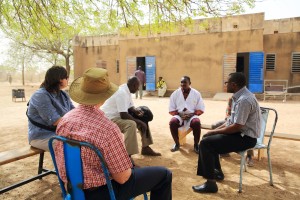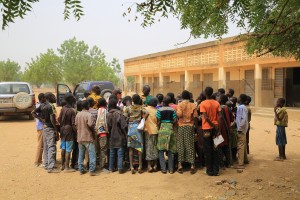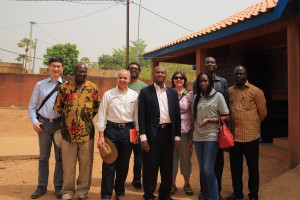A Review of Burkina Faso’s NTD Program: Progress, Challenges and Next Steps
April 21st, 2015

END in Africa Project Director Bolivar Pou shares a laugh with a group of children in Lioulgou, Burkina Faso. Photo: FHI360
In the past few years, Burkina Faso’s Neglected Tropical Diseases Program (NTDP) has made some pretty impressive inroads against several neglected tropical diseases (NTD) that have plagued the country for decades. Among its achievements are reaching World Health Organization (WHO) thresholds for stopping mass treatments (a.k.a. mass drug administration or MDA) for lymphatic filariasis (LF), trachoma and onchocerciasis (oncho) in a respective 52%, 83% and 90% of the health districts where those diseases were previously found.[1] In other words, so few people are infected by these diseases now that there is no longer any need to provide preventative treatments in those districts.

District health workers and END in Africa team discuss challenges and progress around NTD control and elimination in Lioulgou, Burkina Faso. Photo: FHI360
However, the country’s NTDP still has to overcome a few challenges before it reaches its endpoint goals of completely eliminating trachoma, oncho and LF from the country, as well as controlling schistosomiasis (schisto) and soil-transmitted helminthiasis infections within its borders. The leaders of the END in Africa team visited the country in March 2015, to review the NTDP’s progress, conduct field visits to observe project activities, and discuss potential solutions to ongoing challenges.
Putting the Spotlight on NTD Hotspots
Although in its Center East region, Burkina Faso still has several NTD hotspots containing pockets of several different diseases (LF and schisto, in particular), the question that must be answered in each case is the same: Why does this area still have so many disease cases even after receiving NTD medicines for the stipulated number of years, according to World Health Organization (WHO) recommendations?

School children in Lioulgou, Burkina Faso answer questions on schistosomiasis (bilharzia). Photo: FHI360
Such is the case in several districts in the Center East region. In spite of many years of mass treatment, LF cases in several districts in the Center East region still exceed the WHO threshold for stopping mass treatment with preventive medicines.
The district of Lioulgou presents yet another challenge involving schisto cases. Rather than diminishing as expected following many years of mass treatments, disease cases have actually increased by 2% during this period; currently, over half the population of that district (56%) suffers from schisto. The NTDP is conducting an entomology study of the disease-carrying snails in Lioulgou’s three rivers, which is expected to shed light on the situation. However at present, it’s not yet clear why there has been such a sharp increase in cases in this area.
April 2015 NTD Partners Meeting: The Starting Point of the Way Forward
The NTDP is currently developing proposals to investigate the causes of this sharp increase in schisto cases as well as of the persistent high LF prevalence (above 1%) in the region, despite over 10 years of treatment. It will present these proposals on April 21-23, 2015, at an NTD partners meeting in Accra, Ghana, organized by END in Africa and the ENVISION project. As the purpose of the meeting is to discuss pertinent NTD issues as the countries move toward stopping NTD treatments, it offers an opportunity for the NTDP to receive guidance and support for its strategies to address both problems and to implement necessary measures.

Center East Regional Health Director Dr. Sawadogo (center) with END in Africa team in Lioulgou, Burkina Faso
In addition, Dr. M. Sawadogo, Director of Health in the Center East region, and the END in Africa project have already agreed on the need to strengthen mass treatments for LF, oncho and trachoma in every region and district that has not yet met WHO thresholds for stopping treatments. A data quality assessment (DSA) will also be conducted in Burkina Faso in 2016, which is expected to guide measures for improving overall data quality. Together, these steps should enable Burkina Faso to reach and exceed the WHO thresholds for each of these NTDs, and thus, to finally stop mass disease treatments nation-wide in the not-too-distant future.
[1] The NTDP in Burkina Faso has stopped MDA for LF in 33 out of 63 endemic health districts (HDs), for trachoma in 25 out of 30 endemic HDs, and for oncho in 57 out of 63 endemic HDs.

